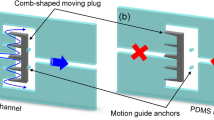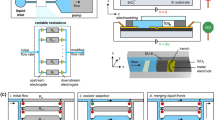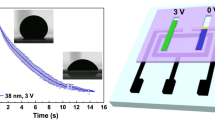Abstract
This paper presents a new microfluidic check valve well suited for low Reynolds number flow rate sensing, micropump flow rectification, and flow control in lab-on-a-chip devices. The valve uses coupling between fluid movement in a channel and an elastomeric column (flap) suspended in the fluid path to generate a strong anisotropic flow resistance. Soft lithography-based molding techniques were used to fabricate the valve, allowing for a low-cost, single-step fabrication process. Three valves—having heights of 25, 50, and 75 μm, respectively—were fabricated and experimentally evaluated; the best of them demonstrated a maximum fluidic diodicity of 4.6 at a Reynolds number of 12.6 and a significant diodicity of 1.6 at the low Reynolds number of 0.7. The valve’s notable low Reynolds number response was realized by adopting a design methodology that balances the stiffness of the elastomer flap and adhesion forces between the flap and its seat. A pair of elastomer check valves integrated with a miniature membrane actuator demonstrated a flow rectification efficiency of 29.8%. The valve’s other notable features include a wide bandwidth response, the ability to admit particles without becoming jammed, and flow rate sensing capability based on optical flap displacement measurements.












Similar content being viewed by others
Abbreviations
- a :
-
gap between the flap and the valve seat
- b :
-
valve seat width
- c :
-
flap clearance
- δ :
-
flap tip deflection
- E :
-
modulus of elasticity
- h :
-
channel height (depth)
- I :
-
second moment of area
- l :
-
length of the flap not in contact with the seat
- L :
-
flap length
- ρ flap :
-
flap density
- ρ fluid :
-
fluid density
- ΔP block :
-
valve blocking pressure
- ΔP free :
-
valve pressure drop in the free flow direction
- ΔP flap :
-
uniform pressure difference across the flap
- Q :
-
volume flow rate
- t :
-
flap thickness
- μ :
-
mass per unit length of the flap
- U :
-
strain energy
- w 1 :
-
channel width
- w 2 :
-
width of channel containing flap
- w 3 :
-
flap width
- ω fluid :
-
first natural frequency of the flap in a fluid
- ω free :
-
first natural frequency of the flap in free space
- γ s :
-
interfacial surface energy
References
Adams ML, Johnston ML, Scherer A, Quake SR (2005) Polydimethylsiloxane based microfluidic diode. J Micromach Microeng 15:1517–1521
Anduze M, Colin S, Caen R, Camon H, Conedera V, Conto TD (2001) Analysis and testing of a fluidic vortex microdiode. J Micromach Microeng 11:108–112
Brenner T, Glatzel T, Zengerle R, Ducrée J (2005) Frequency-dependent transversal flow control in centrifugal microfluidics. Lab Chip 5:146–150
Chaudhury MK, Whitesides GM (1991) Direct measurement of interfacial interaction between semispherical lenses and flat sheets of poly(dimethylsiloxane) and their chemical derivatives. Langmuir 7:1013–1025
Eddington DT, Crone WC, Beebe DJ (2003) Development of process protocols to fine tune polydimethylsiloxane material properties. In: Proceedings MicroTAS. Squaw Valley, October 5–9
Forster FK, Williams BE (2002) Parametric design of fixed-geometry microvalves—the tesser valve. In: Proceedings IMECE, Paper No 33628:431–437
Gamboa AR, Morris CJ, Forster FK (2005) Improvements in fixed-valve micropump performance through shape optimization of valves. J Fluids Eng 127:339–346
Gerlach T (1998) Microdiffusers as dynamic passive valves for micropump applications. Sens Actuators A Phys 69:181–191
Groisman A, Quake SR (2004) A microfluidic rectifier: anisotropic flow resistance at low Reynolds numbers. Phys Rev Lett 92(094501):1–4
Hui CY, Jagota A, Lin YY, Kramer EJ (2002) Constraints on microcontact printing imposed by stamp deformation. Langmuir 18:1394–1407
Hung PJ, Lee PJ, Hu JC, Chen J, Rao VM, Lee LP (2005) A biomimetic elastomer check valve with diode behavior. In: Proceedings MicroTAS. Boston, October 9–13
Jeon NL, Chiu DT, Wargo CJ, Wu H, Coi IS, Anderson JR, Whitesides GM (2002) Design and fabrication of integrated passive valves and pumps for flexible polymer 3-dimensional microfluidic systems. Biomed Microdevices 4:117–121
Laser DJ, Santiago JG (2004) A review of micropumps. J Micromach Microeng 14:R35–R64
Loverich JJ, Kanno I, Kotera H (2005) A novel high energy density dielectric elastomer actuator for micro analysis systems. In: Proceedings MicroTAS. Boston, October 9–13
Nguyen N, Huang X, Chuan TK (2002) MEMS-Micropumps: a review. J Fluids Eng 124:384–392
Pelrine R, Kornbluh R, Joseph J (1998) Electrostriction of polymer dielectrics with compliant electrodes as a means for actuation. Sens Actuators A Phys 64:77–85
Randall GC, Doyle PS (2005) Permeation-driven flow in poly(dimethylsiloxane) microfluidic devices. Proc Natl Acad Sci USA 102:10813–10818
Sader JE (1998) Frequency response of cantilever beams immersed in viscous fluids with applications to the atomic force microscope. J Appl Phys 84:64–76
Sharp KG, Blackman GS, Glassmaker NJ, Jagota A, Hui C (2004) Effect of stamp deformation on the quality of microcontact printing: theory and experiment. Langmuir 20:6430–6438
Stone HA, Stroock AD, Ajdari A (2004) Engineering flows in small devices: microfluidics toward a lab-on-a-chip. Annu Rev Fluid Mech 36:381–411
Tan CKL, Tracey MC, Davis JB, Johnston ID (2005) Continuously variable mixing-ratio micromixer with elastomer valves. J Micromach Microeng 15:1885–1893
Tesla N (1920) Valvular conduit. US Patent No 1329559
Unger MA, Chou H, Thorsen T, Scherer A, Quake SR (2000) Monolithic microfabricated valves and pumps by multilayer soft lithography. Science 288:113–116
Xia Y, Whitesides GM (1998) Soft lithography. Annu Rev Mater Sci 28:153–184
Xia F, Tadigadapa S, Zhang QM (2006) Electroactive polymer based microfluidic pump. Sens Actuators A Phys 125:346–352
Yang X, Grosjean C, Tai Y (1999) Design, fabrication, and testing of micromachined silicone rubber membrane valves. J Microelectromech Syst 8:393–402
Zhang J, Chan-Park MB, Conner SR (2004) Effect of exposure dose on the replication fidelity and profile of very high aspect ratio microchannels in SU-8. Lab Chip 4:646–653
Acknowledgments
The authors are grateful for the support of the Japan Society for the Promotion of Science, Scientific Research (A) (No. 14205037 and No. 15201033), and the Center of Excellence for Research and Education.
Author information
Authors and Affiliations
Corresponding author
Rights and permissions
About this article
Cite this article
Loverich, J., Kanno, I. & Kotera, H. Single-step replicable microfluidic check valve for rectifying and sensing low Reynolds number flow. Microfluid Nanofluid 3, 427–435 (2007). https://doi.org/10.1007/s10404-006-0127-2
Received:
Accepted:
Published:
Issue Date:
DOI: https://doi.org/10.1007/s10404-006-0127-2




